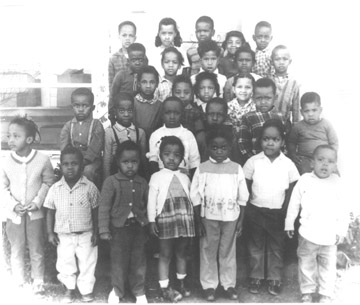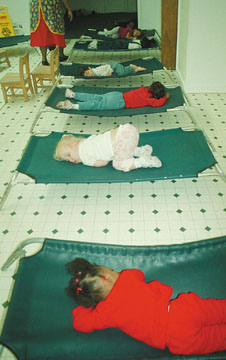2/10/2002 - BLACK HISTORY MONTH: Peterson brought childcare to East side
 At left are several children that attended Mary Peterson's childcare center in 1960. At far right on the top row is Daily Sun writer Ken Hall.Courtesy photo |
By KEN HALL/Special to the Daily Sun
Everyone has heard the phrase "It takes a village to raise a child." Although this particular saying was used by the then first lady of the United States, its origin dated back to a time when African villages realized the need for all inhabitants to have an active part in raising their children.
To take on this responsibility meant putting all personal differences aside for the common good. They knew this was the best way to insure the survival of the community by making sure the youth would grow up with the needed tools to be successful in life.
Even though Mary Peterson and her husband Aubrey had a son and grandchildren, she had a love for all children and felt something was missing for black kids. This belief led her to establish her nursery.
While conducting a Vacation Bible School at Wesley Chapel C.M.E. Church in June 1949, she enlisted the aid of Mrs. Laura Waters and Mrs. Maggie Hall to give the children in attendance some sort of instruction. In the first two weeks they had somewhere around 25 youngsters between the ages of 2 to 10 show up at the morning session. What she found at the end of the day was a situation she had not initially thought of -- many of these kids did not want to leave, mostly because there would be no one home to greet them.
Based on that significant revelation she recalled visiting a day care center on the west side of town run by Mrs. Belle White. Mrs. Peterson discussed the idea with Mrs. Waters and Mrs. Hall about starting something similar on the east side. They agreed, but a place had to be secured. Speaking with Wesley Chapel pastor M.B. Stewart and the church board they allowed Mrs. Peterson the use of the church annex for her program.
Using the example set by Mrs. White, Corsicana Day Nursery No. 2 began without funds from the church, but was allowed rent-free use of the church annex. To offset the costs of food and utilities Mrs. Peterson proposed charging a fee of 50 cents per child per day. Receiving endorsement from all sides of town she began the process of setting the wheels in motion.
With key items such as cots, chairs and tables donated by businesses and churches the dream began to come into focus. Only one more obstacle had to be addressed and no answers were forthcoming: No money was available for her or her two aides for salaries. Mrs. Peterson was reluctant to ask them to work with no pay, but they gave their time willingly.
The dangers of leaving children unattended was graphically seen when fires broke out in homes where youngsters were left alone. Thankfully there were no fatalities, but this made Mrs. Peterson even more determined to continue despite the struggles.
Soon, more children enrolled and Mrs. N.L. Perry was hired as an assistant. Mrs. Perry had taught first grade at Jackson Elementary for 40 years. Additional help also came in the form of community volunteers, and the girls in Jackson High's homemaking department came over to help serve lunch.
Local businessmen recommended Mrs. Peterson apply to the government for surplus food distribution administered by the U.S. Department of Agriculture. She did, and the nursery began receiving much appreciated stores of powdered milk, cheese, butter and dry beans. The donations allowed the nursery to stretch its meager funds. More help came when the facility became an agency of the Community Chest, now known as United Way.
To become an agency affiliate, Mrs. Peterson was told an advisory board would be needed to oversee the nursery operations. Eight members of the community were selected, with Dr. L.L. Smith, a black dentist, serving as the first chairman.
In 1955 the nursery was experiencing growing pains. With nearly 50 youngsters in attendance the annex was no longer large enough to house them. Fortune smiled once more, because a small house located in the 1100 block of East Collin Street was up for sale. Having three bedrooms, a living room, bath and kitchen/dining area the place seemed to be ideal. The only problem was finding $7,000 to purchase it.
Fund raising efforts were soon underway. Members of the board rolled up their sleeves, helping the staff prepare and sell dinners to plant workers once a week. They also delivered. Square dances held in the annex were staged, along with "Tom Thumb" weddings.
 |
| Children at Mary Peterson Child Care Center recuperate after a Valentine's Day Party Thursday Feb 2002. Daily Sun photo/SCOTT HONEA |
These events raised the sum of $2,000, but more funding was needed. Meeting with the Navarro County Foundation board the work in gathering the $2,000 so impressed them that they gave the remaining balance to buy the house. Over the years more such fund-raisers were put on to pay for needed renovations to the building.
The nursery branched out in 1964 and established a smaller venue for a time at the Eastside Apartments for parents unable to bring their kids to the Collin Street location.
Mrs. Peterson held the belief that no child be turned away because their parents could not afford the modest fee. She took it upon herself to find ways to overcome the problem. This too was accomplished when the Head Start program of Community Services stepped in to take up the slack.
Perhaps the greatest tribute to her years of hard work and dedication came in 1972 when the Corsicana Chamber of Commerce presented Mrs. Peterson with the K. Wolens Distinguished Service Award, becoming both the first woman and black person to be so honored. Mary Peterson is no longer living, but her dream and love for children remains as new generations pass through the doors of the nursery that bears her name.
All rights to this story reserved. Copyright Corsicana Daily Sun and Community Newspaper Holdings, Inc,. Content may not be archived, retransmitted, saved in a database, or used for any commercial purpose without the express written permission of the Corsicana Daily Sun and CNHI.